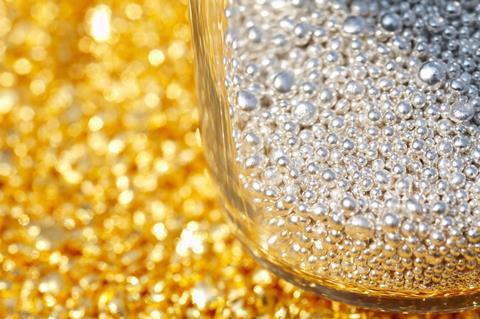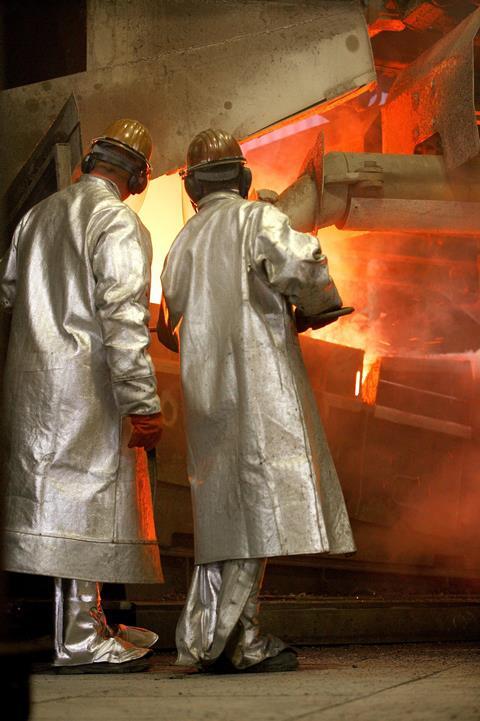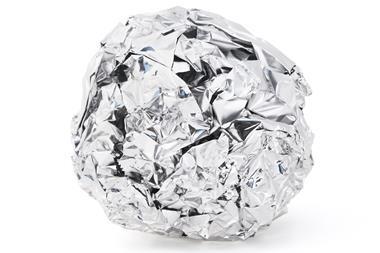Although smartphones contain a host of valuable metals, getting at them is the tricky bit. Emma Davies reports
Most of us have a growing collection of unused mobile phones secreted in a drawer, tied to us by threads of nostalgia or the barriers to recycling electronic goods. Unlike redundant washing machines or television sets, they are small enough to hide and forget. This poses a headache for recyclers keen to recover the host of valuable metals locked inside.
Each phone contains as many as 60 elements, from the thin, conductive later of indium tin oxide on a smartphone’s screen to the lithium in the batteries. As with all electronics, a phone’s micro-electrical components and wiring mainly comprise copper, gold and silver, while tantalum is used in microcapacitors. Elsewhere in the phone, neodymium–iron–boron magnets are commonly used in microphones, speakers and vibration units. Phone composition has changed little over the years, save for increasing levels of indium tin oxide with soaring smartphone demand.
Smashing stuff
In 2013, Axel Müller was a senior geologist at the Geological Survey of Norway. He wanted to illustrate to school children just how many elements are in a phone yet failed to find information from manufacturers. Instead, he decided to crush whole phones and analyse them in bulk. Smashing the phones was doubtless enjoyable but proved the biggest challenge. Muller had to resort to electrical fragmentation, immersing the phones in liquid and applying electrical discharges which transform into destructive acoustic shockwaves.

In a later study, yet to be published, Müller went on to use liquid nitrogen to freeze phones before crushing them. He identified over 60 elements in the phones, all of which contained high levels of gold, silver, copper, tin, indium, tantalum, and nickel compared with the average composition in the Earth’s crust.
Now at the Natural History Museum in Oslo, Müller is the first to admit that his analyses are only ‘semi-scientific’ but they illustrate perfectly how complex phones are. Although such complexity makes recycling a challenge, the relatively high concentrations of valuable metals mean it is ‘economically attractive’, suggests Müller.
Down to Earth
Mobile phone manufacturing brings well-documented concerns over supply of so-called critical raw materials, from precious metals to rare earths. Experts have been discussing the supply issue for almost a decade yet little has changed except perceptions.
The year 2010 saw a media frenzy surrounding certain raw materials, exacerbated when China chose to restrict the supply of the rare earth metals, plus tungsten and molybdenum, used in smartphones. China is the leading global producer of 23 of 41 elements and element groups in the British Geological Survey’s ‘risk list’. Following a World Trade Organisation ruling, China dropped the export quotas in 2015.
Many now object to the term ‘critical’, which depends on a range of factors, from geological abundance to the potential for substitution and even geopolitical factors. ‘It gives the wrong emphasis,’ says David Gardner from Innovate UK’s Knowledge Transfer Network. ‘What’s critical for one person is an opportunity for someone else.’ Listing an element as critical can have knock-on effects. For example, Gardner is aware of cases where an academic project on a new use for an element lost funding after it appeared on a critical list.
‘In our world we see a lot of people in the media and policy makers worrying about physical exhaustion of metals. This is not really the issue,’ says Andrew Bloodworth from the British Geological Survey. ‘The issue is around access and how long it takes to access particular types of metals. Nature distributes them unevenly and sometimes puts them in inconvenient places. The other issue is the demand side,’ he adds. ‘Sometimes it’s hard to predict which technologies are going to take off. If technologies do take off, which metals are they going to use?’

In the mid-1990s, mobile phone ownership stretched further than the reach of City traders, leading to a rapid spike in demand for particular metals. Tantalum supply caused particular issues. At the time, Bloodworth was working for the EU in Namibia helping the government to boost investment in its mining sector. ‘At that time we saw a lot of poor, artisanal miners coming to areas where tantalum occurred and mining it with a pick and shovel,’ he recalls. ‘The conventional mining industry takes time to ramp up to supply demand.’ To this day, tantalum remains at the heart of fierce conflict in the Democratic Republic of the Congo, together with tin, tungsten and gold.
Tantalum is difficult to replace in phones. In fact, all of the metals in a phone have a particular functional use. ‘There has been a lot of work looking at substitutes but the reality is that substitution is very difficult and you have to be careful that you are not jumping out of the frying pan into the fire,’ says Bloodworth. ‘In practice, if you look at the palette of metals, there are supply issues with all of them.’
The urban mine
Recycling would seem a good option. Yet, aside from issues persuading people to part from their phones, current recycling techniques can only recover a limited number of metals, Bloodworth says. ‘Recycling is really challenging,’ he says. Once a phone has been disassembled you are left with a ‘horrendous mix of metals’ that are very difficult to separate from each other. Recycling systems often ‘fall down on economics,’ adds Gardner. ‘The urban mine moves. What you have this year is not going to be the same as what you have next year.’
In the EU, a project called the Critical Raw Material (CRM) Recovery is looking at ‘innovative collection and recovery’ of components of electric and electronic items, including phones. The project focuses on a list of raw materials classified by the European Commission as critical because of their economic importance and a high risk associated with their supply. The list, compiled by an ad hoc working group on defining critical raw materials, includes many mobile phone metals, including antimony, beryllium, gallium, indium, platinum, rare earth metals and tungsten. The project, which began in 2015, is focusing on ways to boost collection of waste electrical items. Plans are in place for trials on collection and recovery/recycling of CRMs in the UK, Germany, Italy and the Czech Republic.
Henning Wilts from the Wuppertal Institute for Climate, Environment, Energy in Germany coordinates the CRM research programme Waste and Resource Efficiency. ‘For a circular economy, you need much better information on material composition of products before it makes sense for the recycling industry to invest in better, but also more expensive, recycling technology,’ says Wilts.
Following the collection trials, recovery trials will evaluate process to collect CRM from electrical items. At least five reprocessing and recovery techniques will be tested, focusing on graphite, cobalt, antimony, tantalum, rare earths, silver, gold and precious metals. Most phones put forward for recycling end up at Europe’s largest recycling centre in Belgium, operated by Umicore, says Wilts. There are two other precious metal refineries in Europe: Boliden, Sweden recycles copper, gold and silver, while Aurubis in Germany focuses on copper.

Umicore’s site in Hoboken, Belgium, is over 300 acres in size and employs around 1500 staff, with 200 in a sampling department and another 100 in an analytical laboratory. It recycles mobile phones and printed circuits with other electronic scrap, although the mobile phone intake is ‘very small’, says Thierry Van Kerckhoven, head of supply recyclables at Umicore Precious Metals Refining. The company mainly focuses on the precious metals gold, silver and palladium but can also recover up to 10 base metals including copper, lead, nickel, tin and antimony.
Electronic material is generally shredded before it arrives at the plant. Umicore then takes a small sample and analyses its metal composition, using techniques such as inductively coupled plasma atomic emission spectroscopy. Electronic scrap is mixed with other precious metal items, including car catalysts, industrial catalysts, and byproducts from the lead and copper industry. It is then put in the smelter, at a temperature above 1000°C.
Plastic components act as a fuel. Meanwhile, the lead attracts non-precious metals and other base metals, while copper pulls out precious metals. The copper and lead fractions are both tapped before being smelted again. This concentration process is repeated until it provides pure silver, gold, palladium, platinum and rhodium as well as salts of iridium and ruthenium and base metals. The entire process can take months, says Van Kerckhoven. What’s left, including small amounts of steel and aluminium, is concentrated into slag, which can be used for other purposes, including road building.
The fact that consumers are holding onto their old phones is definitely restricting supply, says Van Kerckhoven. Of those that are collected, many are re-used. The authorities have a role to play to boost recycling levels, together with producers and importers, he suggests.
Hydro hope
Smelting is not the only way to recycle electronic waste. There is increasing interest in using hydrometallurgical techniques to recover CRMs, for example from phones. Hydro-based systems benefit from a lower initial investment and being able to process smaller quantities of recyclable material than smelting processes, says Bernd Kopacek, who heads the Austrian Society for Systems Engineering and Automation in Vienna.
Kopacek is also responsible for business development at Austrian company ResouTech, which has designed and built hydro-based plants to recover metals from waste items. Materials including shredded circuit boards are treated with strong acids. Hydrogen peroxide is added as an oxidising agent, followed by thiourea to dissolve gold and silver.
In 2015, ResouTech set up a stationary hydrometallurgical recycling plant in Italy. Meanwhile, the company also has a mobile plant to recycle precious and rare metals. This is essentially housed in a shipping container which can be transported as necessary. The mobile plant began operating in Romania in 2016 and is currently located near Rome in Italy. The company has yet to begin recycling mobile electronics but Kopacek envisages that they will be processed separately.

A team at the University of Birmingham, UK is using electrochemistry to recover metals from printed circuit boards. Several years ago, chemist Paramaconi Rodriguez was part of a team at Leiden University in the Netherlands which developed a way to transform bulk metal into nanoparticles using an electrochemical cell. The ‘cathodic corrosion’ technique, using water, salts and electrodes, creates cation-stabilised metal anions from which nanoparticles form.
‘We recently found that we could use the method to remove metals such as gold and platinum from printed circuits of electronic devices such as phones and tablets,’ says Rodriguez. The researchers connect an electrical contact to a complete phone circuit before lowering it into a tank of water with added salts. They then apply a potential between the cathode and the printed circuit.
Early experiments in printed circuit boards show that it is possible to collect gold, platinum, iron and silver nanoparticles in less than one hour. The small-scale process can treat one circuit board at a time although it should be possible to run several circuits simultaneously, Rodriguez suggests. The researchers can tweak the system by changing the electrolyte or the potential applied to target particular metals
There are still several hurdles before the technology finds industrial application. For example, the different metal nanoparticles are mixed together and would need separating. While iron can be removed using a magnet, further smelting or chemical treatment could be required for the other metals.
Magnetic moves
The magnets in phones require a different recycling approach. An EU project called Remanence (rare-earth magnet recovery for environmental and resource protection) aims to identify, extract and re-process neodymium–iron–boron magnets from electronic waste. The project brings together industry and academic partners, including UK research organisation C-Tech Innovation.
At the University of Birmingham, a team led by Allan Walton and Vicky Mann is focusing on separating NdFeB magnets from electronic waste using hydrogen-based technologies they have developed. Working with magnet manufacturers Magnetic Ljubljana in Slovenia and Kolektor Magnet Technology in Germany, the team is developing NdFeB magnets from the waste streams.
Although most of the work has focused on hard disk drives, the process can be tailored to many different waste streams containing NdFeB magnets, including mobile phones, explains Richard Sheridan from the School of Metallurgy and Materials Science.
The team developed a magnetic scanner and robotic system to detect the magnets and feed the sections into a cropping device. The cropped corners are then loaded into a rotating porous drum and exposed to hydrogen at atmospheric pressure and room temperature. The magnets absorb the hydrogen in a process known as decrepitation. An exothermic reaction spreads through the magnet, causing it to expand and fracture to give a demagnetised powder.
The nickel coating peels off and the rotating drum causes the powder to collect. Sieving the powder removes almost all of the impurities. It is then magnetically aligned, pressed and sintered to produce recycled sintered magnets.
Although mobile phones only contain small amounts of NdFeB in the loudspeaker and receiver, as well as in the vibration motor, microphone and camera, initial trials by the Birmingham group suggest that they can recover it. ‘We have plans to investigate this process on a large scale, however this is a long-term project,’ says Sheridan.
The project could find a place in a new University of Birmingham Centre for Strategic Elements and Critical Materials, which is due to open at the end of March 2017. One of the ‘central pillars’ of the centre will be a focus on recycling critical materials from high-tech products, requiring ‘extremely efficient’ separation processes.
We could perhaps help by cutting emotional ties to old phones and handing them on for re-use or recycling. ‘The real message ought to be not so much to worry about recycling mobiles but to make them last a lot longer. What we really want from a phone is a service. We should perhaps be focusing on that instead of as a fashion item,’ concludes Bloodworth.
Emma Davies is a science writer based in Bishops Stortford, UK
Battery boost
Belgian recycling company Umicore has a dedicated battery recycling operation, using smelting to produce nickel and cobalt, which are then used to make new rechargeable batteries.
‘We can close the loop, by recycling and turning the metals into fresh metals again for the manufacturing industry,’ explains Thierry Van Kerckhoven, head of supply recyclables at Umicore Precious Metals Refining
Meanwhile, a recently completed EU-funded project called CoLaBATS used new solvent extraction and recovery technologies to recover metals from used rechargeable batteries. Project teams worked on using ionic liquids and ultrasonics to recover metals including nickel, cobalt and mixed lanthanides from nickel-metal-hydride batteries and lithium-ion batteries.
At the University of Leicester in the UK, physical chemist Karl Ryder worked on using ionic liquids, which have ‘very novel properties in the extraction and recovery of metals from many different waste streams’. The ionic liquids are used to leach metals from a so-called ‘black mass’, the waste electrodes and electrolytes. Whereas other hydrometallurgical processes use strong acids, the ionic liquids are more benign and easier to handle. The liquids can be stripped of metals and re-used in a closed loop process. As part of the project, UK research organisation C-Tech set up a pilot plant, to process lithium ion and nickel-metal-hydride black mass.













3 readers' comments